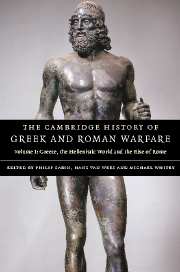Book contents
- Frontmatter
- Introduction: The Historiography of Ancient Warfare
- Part I Archaic and Classical Greece
- Part II The Hellenistic World and the Roman Republic
- 10 International relations
- 11 Military forces
- 12 War
- 13 Battle
- 14 Warfare and the state
- 15 War and society
- Chronological Table
- Glossary
- List of Ancient Authors
- Bibliography
- Index of ancient passages cited
- General index
- Map 1 The western Mediterranean
- Map 3 The Near East
- References
10 - International relations
from Part II - The Hellenistic World and the Roman Republic
Published online by Cambridge University Press: 28 March 2008
- Frontmatter
- Introduction: The Historiography of Ancient Warfare
- Part I Archaic and Classical Greece
- Part II The Hellenistic World and the Roman Republic
- 10 International relations
- 11 Military forces
- 12 War
- 13 Battle
- 14 Warfare and the state
- 15 War and society
- Chronological Table
- Glossary
- List of Ancient Authors
- Bibliography
- Index of ancient passages cited
- General index
- Map 1 The western Mediterranean
- Map 3 The Near East
- References
Summary
The Hellenistic age ushered in a new era in the international relations of the Greek world, in that it drew the relatively small-scale system of Greek city-states and ethnê into the much larger system of the Hellenistic monarchies; and in that the Hellenistic monarchies were dominated by royal families and élites drawn from the hitherto remote and backward region of Macedonia in northern Greece. For centuries, down to the middle of the fourth century BC, Macedonia had stood on the fringe of – some would say entirely outside – Greek civilization and its developments. It seems legitimate to wonder therefore whether, in taking over the Greek world and expanding the horizons of Greek civilization to encompass the lands of the old Persian empire, the Macedonians brought to the practice of international relations any special ideas, policies, systems or formulas of their own, distinct from those of the city-state Greeks.
They did not. In unifying Macedonia and leading it to a position of dominance in the Greek world during the third quarter of the fourth century, king Philip II necessarily adapted his diplomacy and his practice of international relations – modes of negotiation, style of treaties, alliances, and other agreements – to the ideas and systems of the more advanced city-state Greeks. Even his role as a near-absolute monarch, able to conduct diplomacy and international relations more or less as he saw fit, was paralleled in the world of the Greek city-states by the great tyrants they from time to time produced, like Dionysius I of Syracuse, for instance.
- Type
- Chapter
- Information
- The Cambridge History of Greek and Roman Warfare , pp. 301 - 324Publisher: Cambridge University PressPrint publication year: 2007

